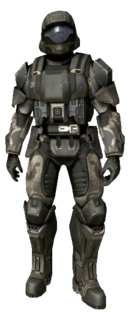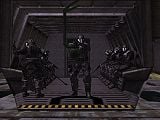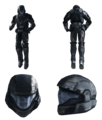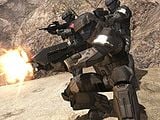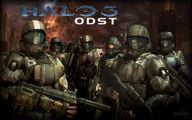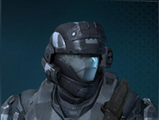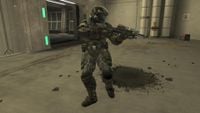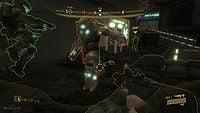ODST armor
From Halopedia, the Halo wiki
The ODST battle armor, or Battle Dress Uniform (BDU for short), is a suit of combat armor worn exclusively by the Orbital Drop Shock Troopers, special operators of the UNSC Marine Corps.
Introduction
The ODST body armor is a signature piece of equipment used by the Orbital Drop Shock Troopers. It is vacuum-rated and is capable of Extra-Vehicular Activity for fifteen minutes.[1] The armor provides numerous advantages in the field, including ballistic protection, temperature control, as well as thermal insulation against extreme temperatures experienced during atmospheric entry and thermal protection from Covenant energy weapons.
The ODST Armor has gone through several design changes since the start of the Human-Covenant War. The current version incorporates technology initially developed for the MJOLNIR Powered Assault Armor, most notably the helmet.[2] This also includes CTCs for body armor and titanium and ceramic composite armor plating to give the user added protection. It features Heads Up Display and communications systems, notably the Visual Intelligence System, Reconnaissance, to give more situational awareness to the wearer.[3]
The ODST BDU has been in use for well over 50 years and remains unmatched in its ability to protect its wearer over other BDUs during the toughest operations. The BDU excels at providing more protection against small arms fire than other infantry body armor, and also excels at allowing a trooper to conduct Military Operations in Urban Terrain (MOUT) without little chance of being detected in dark locations. The BDU's stealth capability is partly thanks to its black and gray camouflage patterns on the legs, boots, gloves, chest, helmet and undersuit - these urban camouflage patterns are optional; without the camouflage panels, the BDU is black. On the left shoulder pad of every ODST is a UNSC MED REF patch.[4][5][6] This patch contains basic medical information about the trooper, and allows a certified medic to gain a quick medical reference to an ODST wounded in the field. Despite the armor's obvious advantage over standard infantry armor, it is still vulnerable to Covenant energy weapons, larger armor piercing rounds, and large explosive devices.
Armor variants
While the standard ODST BDU is fully capable for any role, there are specialized variants of the BDU - these suits are specifically issued to a specialist of a certain field to provide them certain advantages during an operation. As such, specialized gear is only available by Mission Conditional Requisition (MCR). Depending on mission requirements, an ODST operative may request either additional, or variant equipment that ranges from helmet attachments, gloves, battery, equipment or communication rucksack. The following is the specialized battle dress uniforms currently in use by the Navy.
Close Quarters
While designated as a Close Quarters Battle (CQB) suit, this variant is also issued to demolition experts. This version of the battle armor is specifically designed to aid an ODST in CQB-type combat conditions. The standard left pauldron is replaced with a longer two-piece ballistic plate, which aids in protecting the trooper's upper body while in a firing stance, and also to reduce severe injury from plasma-based weaponry. The helmet is also issued with an optics device that aids the user in relaying images and video to teammates or command.
Sharpshooter
The sharpshooter BDU is issued to sniper experts in the field. This BDU is designed to give an ODST sharpshooter more freedom in combat - the standard right pauldron is removed, allowing the sniper to aim better and move his arm more freely with a sniper rifle, while the standard left pauldron is replaced with a larger plate to protect the sniper's arm from counter attacks. The sharpshooter variant is also issued with an optics device attached to the helmet, while the Oracle scope on the SRS99 can uplink to the user's HUD.
Recon
The reconnaissance BDU is a specialized Office of Naval Intelligence variant of the ODST armor. The armor is only issued to ONI reconnaissance agents for high risk operations. The undersuit is the same as the standard ODST armor. However, the chest plate is replaced with a specialized one, to provide stealth capabilities with little or no loss of endurance, specifically by reducing its IR signature and reflective surfaces. The torso part of the armor also varies from the standard version, having a green, translucent orb in the center. There are no shoulder plates issued with this variant, which allows more freedom of arm movement.
Unidentified variant
There is another variant of the ODST armor that has not been identified. Such suits were used by ODSTs Gretchen, Dutch, and Romeo wore during a mission some time prior to the Battle of Ariel. It differs greatly from the normal ODST armor in that it bears a great resemblance to standard Marine armor. The chestplate that Romeo wore was olive drab in color, and appeared almost identical to those worn by the Marines. However, the armor retains the basic form of the ODST armor, with standard helmet and bodysuit pieces obviously shown. It is possible that this variant is either an earlier version of the armor or a field-expedient modification. This suit bears a noticeable resemblance to the armor worn by ODSTs in Halo 2.
Armor components
The ODST battle dress uniform is comprised of several different components and layers that make the suit what it is, while technology from other projects across the military have been incorporated into the suit, ODST equipment still has proprietary technology that has not been adopted into other equipment for the military.
Helmet
The ODST helmet, which was originally designed for use with MJOLNIR armor[2], is made of titanium, coated with a heat resistance material to help disperse heat - the inside is lined with black padding to provide comfort when the user is wearing it. The helmet's faceplate is made of a strong, glass-like material with the ability to polarize. When polarized, the helmet's faceplate has a blue-silver color to it, and obscures the wearer's face completely.
The helmet provides excellent protection against small-arms fire and small explosive attacks. The helmet is also essential in providing an ODST the ability to perform EVA and also provides a Heads Up Display, giving the wearer basic information including a targeting reticule, weapon information, ammo capacity, and basic health readout. The newest version of the helmet integrates with the user's standard Neural Interface to provide more tactical data to the HUD. Helmet-integrated neural interfaces is another piece of technology that has seen widespread adoption from Project MJOLNIR. Along with this state-of-the-art equipment, the helmet is also equipped with its own thermal imaging and motion sensors.[7] The MJOLNIR Powered Assault Armor/AA variant, which was developed as an improvement of the ODST helmet, was introduced in 2535. It was eventually adopted as the standard helmet of UNSC Army airborne units.[8]
VISR
- Main article: Visual Intelligence System, Reconnaissance
The Visual Intelligence System, Reconnaissance, or VISR, is issued with the ODST helmet. The VISR proprietary data management suite enables a user to link into UEG, CAA, and UNSC infrastructure systems at the local, national, and global levels - however actual access level is administered on a need/rating basis.[9] This allows the user to store and review mission content up to 610MB combined, the system also provides street level navigational data, and receive secure real-time mission data. In addition, every current issue helmet ODST BIOS A29.817941B.01 or later is equipped with low-light vision enhancement, which outlines hostile units in red, friendlies in green, weapons in blue, and objects of interest in yellow.[5]
Rucksack
The rucksack issued to ODSTs is, for all intents and purposes, an armored backpack that attaches to the back of the armored vest. The rucksack comes in a number of different variants. The main purpose is storage, which allows a trooper to store equipment, ranging from ammunition, to medical supplies, to explosives, to battery packs which provides power to any equipment an ODST may carry, and communications, which houses the necessary radio and satellite gear that an ODST squad requires to report in to their superiors. For longer missions, ODSTs can carry larger rucksacks with enough supplies for two weeks of operation without external resupply.[10] Rucksacks have integrated magnetic holding devices to allow for external back mounting of additional equipment. Equipment with magnetic properties, such as longer weaponry, can be carried externally over the rucksack eliminating the use of extra straps or slings. Because the rucksack's casing is armored, it gives the ODST wearing it an additional layer of protection from behind.
Body suit
The ODST body suit is comprised of several different layers and materials. The inner layer of the black-gray undersuit is made of Kevlar to aid in protecting the wearer from small arms fire. The inner layer contains a heating and cooling system which regulates temperatures to keep the user warm or cool depending on the weather conditions - the heating and cooling system can also match infrared signatures of the current weather as well to allow an ODST to go undetected in hostile locations.[7] The outer layer of the undersuit is coated with a heat-resistant material to aid in reducing temperatures experienced during orbital drop, and against Covenant plasma weapons. The body suit also doubles as a pressure suit to allow an ODST to perform extra-vehicular activity. The outer shell layer is comprised of titanium and ceramic composite armor plating that covers the chest, shoulders, legs and feet.
Halo 3 multiplayer and Halo: Reach Armory
Halo 3
The ODST battle helmet is available as an armor permutation in Halo 3 multiplayer. The SPARTAN version of the helmet differs from the standard version in the polarization color of its visor; regular ODST helmets have bluish-silver polarization, while the MJOLNIR ODST helmet retains the gold electroplating possessed by most MJOLNIR armor. It is unlocked by earning the Spartan Graduate achievement, or by earning 5 XP in Matchmaking.[3]
Halo: Reach
In Halo: Reach, two uprades are availible for the helmet. The first, (UA/CNM), adds an up-armor plate with a Command Network Module on the left side, and the second, (CBRN/HUL), adds a Chemical, Biological, Radiological, and Nuclear Module with a Hardened Uplink Module on the right side. The shoulder pauldrons, breastplate, and helmet of the ODST armor are also available for purchase in the Armory. Unlike in Halo 3, the ODST armor can be used in all game modes.
Trivia
- The ODST armor is derived from the first concept of the MJOLNIR armor. This original concept done by artist Shi Kai Wang was scrapped because it made the Master Chief look "too mean."[11]
- The visor's ability to polarize, the VISR mode, and the HUD it displays may mean it has a transparent Organic Light Emitting Diode (OLED) screen coating it.
- The Good Samaritan achievement unlocks the ODST armor for your Xbox Live Avatar, if the user has Halo Waypoint. It's listed under the "Awards" section when customizing the avatar.
- The armor used by the ODSTs in Halo 3: ODST is the same as the suit used in Halo 3, despite the game taking place during the events of Halo 2. This suggests that the changes between the games are merely aesthetic and that there is no canonical difference between the Halo 2 and Halo 3-era suits.
- The ODST armor worn by the squad in Halo 3: ODST have the exact same scratches and burns. All the male members of the team wear the exact same armor with different colors and "Add-ons". This is easy to see if you pay attention to the chest plate, they all have the same scratches.Template:Fact
- The fact that ODST chest armor is able to withstand a blow from the blade of a Gravity Hammer (although the wearer suffered a punctured lung) is a testament to the toughness of this armor compared to normal marine armor which could never survive a blow like that.
- Despite being named "Mark V," the "Flaming Mark V helmet" for the Xbox Live Avatar is actually a ODST helmet. Though one could say it is the Mark V variation of the ODST helmet as seen in Halo: Reach.
Gallery
- ODST - Helmet Concept.png
Concept art of the ODST helmet.
Private S. Hartley during the Battle of Sector Six from Halo: Landfall.
- Char odst.jpg
The ODST BDU in Halo 2.
The Rookie's armor from Halo 3: ODST.
An Xbox LIVE avatar award unlocked via Waypoint and an achievement.
- Halo-reach-20100806092438101.jpg
An ODST helmet on a suit of MJOLNIR armor in Halo Reach.
Sources
- ^ Halo: The Cole Protocol, Chapter 4: page 48, Chapter 5: page 56
- ^ a b Halo: Reach: ODST helmet Armory description: "Many technologies initially developed for MJOLNIR have gained widespread adoption."
- ^ a b Halo 3
- ^ We Are ODST
- ^ a b Halo 3: ODST
- ^ Halo: Landfall
- ^ a b Halo Encyclopedia, Chapter 2: page 57
- ^ Halo: Reach, Armory: AA helmet description
- ^ Bungie.net: Halo 3: ODST Field Guide
- ^ Halo: The Flood, page 58
- ^ The Art of Halo 3
